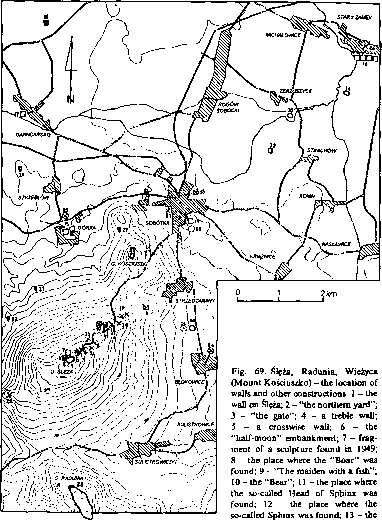image085

9. Sacred mountains “A mountain - as M. Eliade wrote (1966, p. 101-102) - is close to the sky and this fact sanctifies it in two aspects: on the one hand the mountain participates in the spatial symbolism of the transcendental (ideas such as "high,” "vertical,” “the highest,” etc.), on the other it is an area strictly reserved for atmospheric hierophanies and thus the seat of gods. Each mythology has its holy mountain, a variant of the Greek Olympus.” The mountain is also connected with the mythical arrangement of the world in the horizontal dimension, as it stands at the intersection of the four direc-tions, the point through which the axis mundi goes (Eliade, 1988, p. 4).
Mountains often functioned as sanctuaries. According to Herodotus (I, 131), the Persians “customarily bring offerings to Zeus, climbing the highest peaks.” The Normans settled in England worshiped Odin by sacrifi-ces on high hills (de Vries, 1956-1957, vol. 1, p. 345). In Slavonic territories many mountains whose peaks had been surrounded with Iow stone walls interpreted as constructions enclosing the sacred space were found.
A very good example is Ślęża, the peak of the largest massif in Silesia north of the Sudeten. It seems that this elevated mountain strongly im-pressed the German army marching against Boleslaus the Brave. Thietmar (VII, 59), on the basis of the relations of the participants of the events, with his own hand wrote in his chronicie about Niemcza that “this stronghold lies in the country of Silesia, which was once named after a large and very high mountain,” and further dictated to a scribe: “That mountain was greatly respected by ałl inhabitants because of its enormity and of destiny, as the cursed pagan rituals were held there.”
The sanctuary had been destroyed by the times of Boleslaus the Brave (early llthc.), which follows from Thietmar’s using the past tense (Leciejewicz, 1987, p. 125). His chronicie provides us with the only unąues-tionable information about this sanctuary. Ali other mentions, as well as archaeological, ethnographic and toponomastic sources used in the extensive discussion over the issue of Ślęża as a pagan cult centre, if disconnected from Thietmar’s words, do not constitute conclusive evidence. Hence, Thietmar has to be treated as a basis for all further deliberations.
Ślęża (Zobtenberg) is the highest peak of the massif. Stone walls sur-round also two neighbouring peaks: Radunia (Geiersberg) and Wieżyca
“Mushroom”; 14-17 - Roman lions; 18 - the place where the “Monk” was found; 19-23 - St Andrew’s crosses on gabbro rocks; 24-26 - crosses on stone blocks; 27 - old ąuarries; 28 - the embankment on Radunia; 29 - the embankment on Wieżyca; 30 - the stronghold in Będkowice; 31 - the place where the Sobótka column was found; 32—34 — strongholds. After H. & W. Hołubowicz, 1952a, piąte 86.

173
Wyszukiwarka
Podobne podstrony:
skanowanie0084 (2) •fwl dictation, ttt dicto-comp - students listen to the passage and then summaris
20641 Opel Immo2 TMS2 Step 3. De-solder these two points as this is where the aerial is connected to
image002 iianttne/Novol/2426Q ’ł1 WHAT HAUNTING LULLABY LLRED AMERICA S LEAI1IMG BRAIN SURGEON
26 PRO)ECT FIVE • 8EA0E0 AMULET PURSES Be surę to puli the warp threads close to the woven beads as
- used as a cover over the working surtacc. Ali blobs o: adhesiee can be wiped on to the edge and yo
76843 MR293R190?7 1 COHPOBTTION OF COHPONENT AS SUPPLIED BY PARTS DEPARTMENT- Basic parL COtCMBCTION
Suzuki RM125G MACHINĘ TUNING 4-3 As shown below, each tuning part is located between the air/fuel pa
system 22 22 later as most strengthening to the digestion and the intestinal functions. There are ot
as also cAlso - Too - As Weil - SoAlso I went to the park and I also went to the bank. I went to the
used as a cover over the working surrace. Ali blobs of adhcsiee can be wiped on to the edge and you
as (8) This ring is a snap to work up. and no one will befceve ihat you madę it us*ng hairpin c
image091 Further three hills viewed as sacred mountains are situated in Pomerania. In Rowokol, where
więcej podobnych podstron